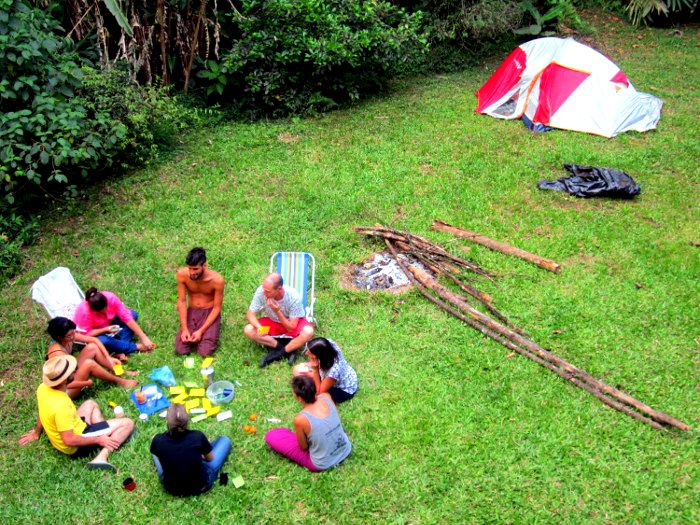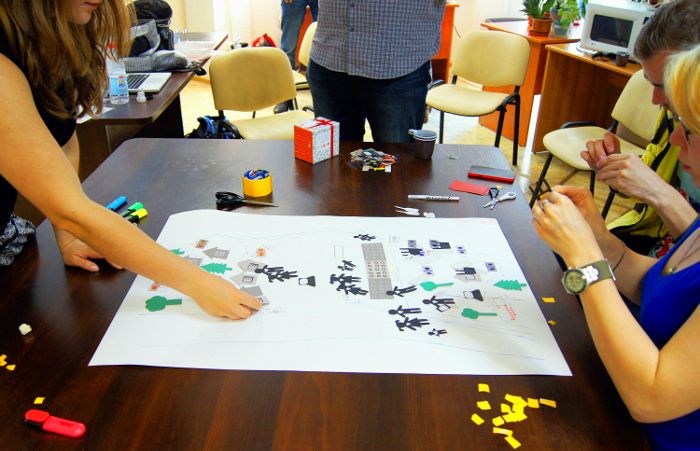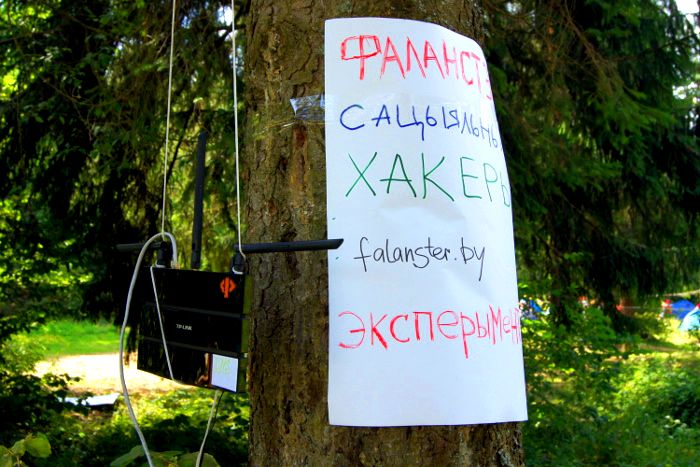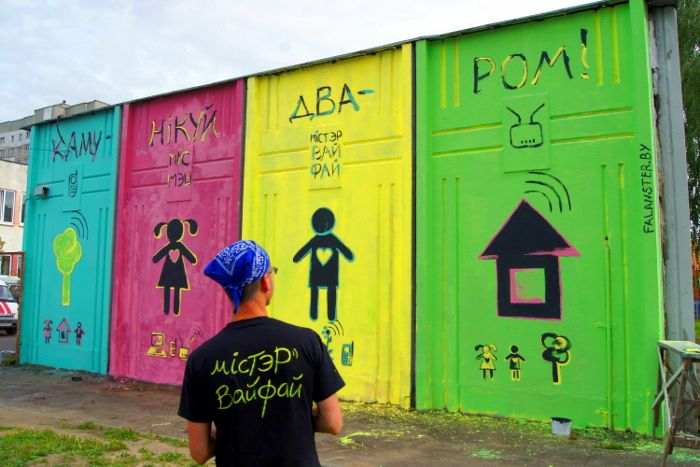Year ago it was hardly to imagine that I would communicate with different communities and make four field experiments with a mesh network in Belarus. In the blog post I will summarize my experience over this year and focus just on moments which were the most important for understanding technologal impact on to different communities behaviour during their annual festival.

Definitions
[Topic] community is the group of people with common behavioural patterns which addresses one or several challenges and use at least one approach (translator) in their external communication with the challenge(s). There are several example of translators: Cyclist can user Critical Mass rally each last Friday of a month or Chaos Communication Club has an annual event Chaos Communication Conference.
First case. The Youth festival. Informal educational community
May, 2015
The main idea was to cover a big hangan in Kastrychnitskaya Street (TSECH creativity space) during one day youth gathering. The organizers expected about 200 participants. Six places were fulled by speakers simultaneously. Each place was under one volunteer's duty. The event took place on two separate floors.
Achievements:
- We first time launched a mesh network with several applications and internet access.
- We realized that we need more detailed collaboration with organizational team. Not just allowing to make mesh deployment.
- The knowledge about “mesh” were seeded among different communities which participated in the event.
Challenges:
- The “mesh” strategy should integrate as early as possible in festival team activity. It means the organizators understand why a mesh network layout they need and how the will make announce for audience.
- The core mesh team needs to make convention about network architecture and building process as detailed as possible and before. Don’t remain all mounting activity on the eve of event.
- It is not enough one mesh contact with festival team volunteers. They are usually not a technical guys. It demands to prepare developed guides and demonstrate how it works before festival not just.
The was amazing experience how different educational communities could understand and at the same time reject technical injection in their extra routine communication.
Second case. Mesh in the forest. Tech geeks community
June’2015
The case was implemented in the forest near Hrodno (west region). We deployed three mesh network nodes for two Linux Vacation of Eastern Europe (around 120 attendees) days converence. Month before we had organized a collaborative session where engaged opensource activists for co-modelling the future network.

Achievements:
- We worked in the forest conditions first time and setup a network which include two microservers with the application (media grid and etherpad). We tuned a splash page for newcomers.
- Community tried to use some services for their specific needs. For instance, demonstration how 3D-printer was working during we made presentation for participators.
- We could collect many ideas how we can use the type of network for geek communities events during brain storms in forest session as well as in co-modeling meeting.
Challenges:
- The tech guys didn’t surprise by some new technologies. Now they like something more social inside technology. What is it a social problem for them?
- A new volunteer in team is very useful on Physical, Data link OSI levels during network mounting but not on Network or Transport OSI levels. In other words, even a high skilled guy started to make intervention in network configuration it can be useless or often worse because of poor co-modelling knowledge and common vision lack.
The experiment showed me strong point for collaborative planning and defining community needs.
Third case. Mesh on the river coast. Business community
Jule, 2015
It was an open air three days festival for young entrepreneurs with around 200 customers. Lipen.pro. This time we landed our network on several grasslands in the middle of dense forest with not high but steep hills. We deployed the net with initial web-services and make a poster campaign near most people concentrated tents as well.

Achievements:
- We adopted a network configuration in forest conditions, used an autonomous electrical generator and covered about 70% of a festival area.
- We had a number of face to face communications and seed a “mesh‘ idea in leaflets and stickers among young "business" people.
- The understanding come that a pure network with web-services is low-attractible because of lack of tangible interface for non-geeks. It needs to add more social activities and complimented services such as a mobile power charge station for smartphones or sensible festival information inside a network. The posters were not enough to increase attendees’ interest in mesh using.
Challenges:
- Non-technical people prefered to choose sporadical walking and talking in nearest circle rather than collaboration in some virtuale level with a whole festival community.
- Don’t rely on organizators' understanding of common concept of mesh. It needs to engage them in co-creation and integration network features as a substantial part of a festival. For example, it can be a schedule and any festival announcements in a mesh network. The measures can help to overcome advertisement barrier or lack of volunteers on the first step. Or another possible example, it is to "integrate" network information in a festival website.
- It is necessary to prepare long working electrical sources and diversify their number: the more the better (for mesh it is very essential). At summer a solar panel usually works perfectly.
Here, firstly, I felt that just a new stereotype (pattern) can destroy prevoius one. It is not knowledge. Secondly, boundary of scalability in community translators is challange for any "external" input.
Fourth. We come back to the hangar. Queer community
September, 2015
Metafest, around 250 participators. This time the main task was to provide Internet access for audience and org team. We made two nodes mesh network in hangar where we were first time (see case 1) and setup there the same web-services. The festival occured in night atmosphere (all windows were closed).
In the interaction in understood that community core can feel necessaty but doesn't understand shift regading to a new possible technological level and behavioural pattern.
Achievements:
- We attracted volunteers for mesh network deployment as well as its advertising.
- The organizer invited us and required to make mesh.
- We made two Internet gateways in mesh. The gateways could ensure each other in case of emergency of one of them.
Here many of our challenges were typical with previous. I would like to summarize possible solutions for them.
Firstly, It is very important to begin “mesh” communication with an organisational team as early as possible. It has to be more than 3 times with core community (festival) team and 2+ times with volunteers.
Secondly, the advertisement needs to be with different mediums: off-line posters, online, live communication with participators in early beginning on the festival, may be a suitable moment when the attendees just arrive and register. Make big provoked posters and ads. Use a loudhailer.
Thirdly, the network should be modeled with (!) organizator team and potential networks needs have to b developed by the org team plus volunteers. Because festival organisers are usually core of community which has deep understanding of target audience needs.
Last but not least, the network should be composed and tested in a laboratory many times. It is a golden rule.
On the edge
What about political conditions for this activity? In our country people usually ask: Is "mesh" legal? We are on the margin. Sure it is very hard to develop the type of activity in terms of legislative barrier for any outside activities in general. Today we have very strict spectrum management law as well as regulation of any civil agency in Belarus. I think the regulation needs to be but now the regulation in a telecommunication sphere (market) are opened just for big corporations (Velcom, MTS, Beltelekon). Non-huge local and topic communities has no access or chances to get the licence and deploy outside networks without big bureaucratic procedures even if they want to link just two houses in a rural area. What does it mean? It means that now we've just begun to shape new community rights - community digital rights.
The belarusian battle of mesh will be continued...

Photos are made by Talash and Sviatlana Yermakovich (kler)